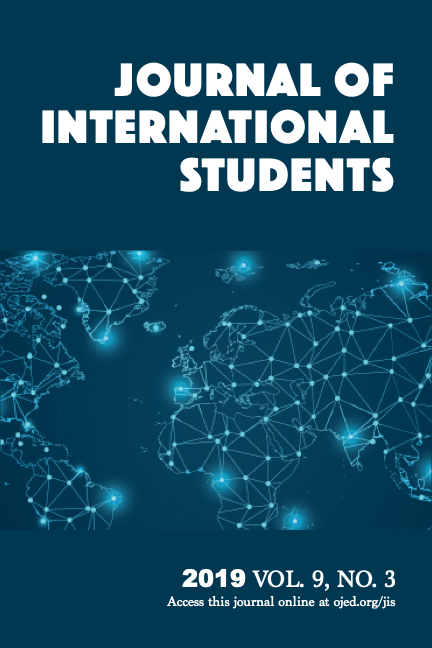Familiarity as a Family
Close Friendships Between Malaysian Students and their Co-National Friends in the UK
DOI:
https://doi.org/10.32674/jis.v9i3.732Keywords:
close friendships, co-national friends, familiarity, homophily, Malaysian Students, sense of belonging, spaceAbstract
The purpose of this study is to explore close friendships and intimacy practices of Malaysian students in the context of living abroad. Some of the new close friends, specifically co-national friends in the UK, are perceived as “family” although some of them have not yet acquired family-like qualities in their relationships. Due to the situation of living abroad, the students acquired the “familiarity as a family” relationship—a new concept introduced in this study to explain this complicated relationship, with co-national friends in the Malaysian community in the UK. A sense of belonging and homophily, and shared physical space and activities are two key factors that influenced these practices of intimacy, which will foreground the discussion in this paper.
References
Ahmad, A. L., Mirza, E., Mohd, R. H., Pawanteh, L., & Salman, A. (2014). Adaptation and the New Media Technology : a Study on Malaysian Students in Australia and United Kingdom. Malaysian Journal of Communication, 30(1), 195–206.
Alazzi, K., & Al-Jarrah, A. (2016). Southeast Asian International Students Adjusting to Jordanian Universities: Views From the Field. Journal of College Student Development, 57(6), 730–741. http://doi.org/10.1353/csd.2016.0071
Beech, S. E. (2014). Social & Cultural Geography International student mobility: the role of social networks. Social & Cultural Geography, 9365(May), 37–41. http://doi.org/10.1080/14649365.2014.983961
Beech, S. E. (2016). The Multicultural Experience? ‘Cultural Cliques’ and the International Student Community. In D. Jindal-Snape & B. Rientes (Eds.), Multi-dimensional Transitions of International Students to Higher Education. London: Reed Business Information Ltd, England.
Bilecen, B. (2014). International Student Mobility and Transnational Friendships. London, United Kingdom: Palgrave Macmillan.
Brown, L. (2009a). An ethnographic study of the friendship patterns of international students in England: An attempt to recreate home through conational interaction. International Journal of Educational Research, 48(3), 184–193. http://doi.org/10.1016/j.ijer.2009.07.003
Brown, L. (2009b). International Students in England: Finding Belonging through Islam. Journal of Muslim Minority Affairs, 29(1), 57–67. http://doi.org/10.1080/13602000902726772
Coleman, J. A. (2015). Social circles during residence abroad: What students do, and who with. Social Interaction, Identity and Language Learning during Residence Abroad, 33–51.
Geeraert, N., Demoulin, S., & Demes, K. A. (2014). Choose your (international) contacts wisely: A multilevel analysis on the impact of intergroup contact while living abroad. International Journal of Intercultural Relations, 38(1), 86–96. http://doi.org/10.1016/j.ijintrel.2013.08.001
Gillespie, B. J., Frederick, D., Harari, L., & Grov, C. (2015). Homophily, Close Friendship, and Life Satisfaction among Gay, Lesbian, Heterosexual, and Bisexual Men and Women. PloS One, 10(6), e0128900. http://doi.org/10.1371/journal.pone.0128900
Glass, C. R., Gómez, E., & Urzua, A. (2014). Recreation, intercultural friendship, and international students’ adaptation to college by region of origin. International Journal of Intercultural Relations, 42, 104–117. http://doi.org/10.1016/j.ijintrel.2014.05.007
Gu, Q., & Maley, A. (2008). Changing Places: A Study of Chinese Students in the UK. Language and Intercultural Communication, 8(4), 224–245. http://doi.org/10.1080/14708470802303025
Jamieson, L. (2013). Personal Relationships, Intimacy and the Self in a Mediated and Global Digital Age. In K. Orton-johnson, N. Prior, L. Jamieson, & K. Evans (Eds.), Digital Sociology: Critical Perspectives (pp. 13–28). Palgrave Macmillan.
Lim, S. S., & Pham, B. (2016). ’If you are a foreigner in a foreign country, you stick together: Technologically mediated communication and acculturation of migrant students. New Media & Society, 1461444816655612. http://doi.org/10.1177/1461444816655612
Maundeni, T. (2001). The Role of Social Networks in the Adjustment of African Students to British Society: Students’ perceptions. Race Ethnicity and Education, 4(3), 253–276. http://doi.org/10.1080/13613320120073576
Mcpherson, M., Smith-lovin, L., & Cook, J. M. (2001). Birds of a Feather: Homophily in Social Networks. Annual Review of Sociology, 27, 415–444.
Morgan, D. (2011). Rethinking Family Practices. Great Britain: Palgrave Macmillan.
Nielsen, K. (2014). Study abroad: perspectives on transitions to adulthood. University of Sussex.
Office for National Statistics. (2017). Population of the UK by country of birth and nationality. Retrieved from https://www.ons.gov.uk/peoplepopulationandcommunity/populationandmigration/internationalmigration/datasets/populationoftheunitedkingdombycountryofbirthandnationality
Prazeres, L. (2016). Challenging the comfort zone: self-discovery, everyday practices and international student mobility to the Global South. Mobilities, 0101(February), 1–16. http://doi.org/10.1080/17450101.2016.1225863
Rienties, B., & Nolan, E. M. (2014). Understanding friendship and learning networks of international and host students using longitudinal Social Network Analysis. International Journal of Intercultural Relations, 41, 165–180. http://doi.org/10.1016/j.ijintrel.2013.12.003
Spencer, L., & Pahl, R. (2006). Rethinking Friendship: Hidden Solidarities Today. Princeton & Oxford: Princeton University Press.
UKCISA. (2015). UKCISA - International student statistics in UK higher education in 2013-14. Retrieved March 3, 2015, from http://www.ukcisa.org.uk/Info-for-universities-colleges--schools/Policy-research--statistics/Research--statistics/International-students-in-UK-HE/#International-(non-UK)-students-in-UK-HE-in-2013-14
Uski, S., & Lampinen, A. (2014). Social norms and self-presentation on social network sites: Profile work in action. New Media & Society, 1–18. http://doi.org/10.1177/1461444814543164
Weeks, J., Heaphy, B., & Donovan, C. (2001). Same Sex Intimacies: Families of Choice and Other Life Experiments. London: Routledge. http://doi.org/10.4324/9780203167168
Weiner, a. S. B., & Hannum, J. W. (2012). Differences in the quantity of social support between geographically close and long-distance friendships. Journal of Social and Personal Relationships, 30(5), 662–672. http://doi.org/10.1177/0265407512465997
Weiss, M. L., & Ford, M. (2011). Temporary Transnationals: Southeast Asian Students in Australia. Journal of Contemporary Asia, 41(March 2015), 229–248. http://doi.org/10.1080/00472336.2011.553042
Published
Issue
Section
License
All published articles are licensed under a Creative Commons Attribution-NonCommercial-NoDerivs 4.0 Unported License.















